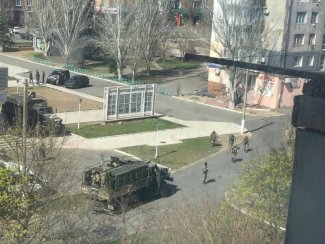Terror, pacification, occupation. Russia’s actions in the occupied territories of Ukraine

Russia’s aggression against Ukraine has put the problem of how to manage the territories it has occupied onto the agenda. The first phase of the land operation did not lead to the capture of any significant areas, destroy the enemy’s army, force the Ukrainian government to flee Kyiv or suppress civil resistance, so it ended in failure – not only militarily, but also politically. The plans to force the inhabitants of the occupied territories into supporting the invaders and establish so-called ‘people’s republics’ there in order to further fragment the Ukrainian state have also ended in failure. The Kremlin, acting according to its modus operandi from 2014, has once again failed to take into account the changes in the attitudes of Ukrainian society, which does not see Russia as a civilisational alternative. Despite the risks associated with doing so, the locals have been protesting in large numbers, and cases of collaboration with the occupiers have been sporadic, which has made it impossible for the latter to exert their full and undisturbed control over the captured territories. And as the invaders see that their actions are ineffective, they take revenge on the civilians: they use terror and pacification, commit war crimes, and bring about humanitarian catastrophes in the occupied towns. The results of the operation so far show that its initial aim was to destroy the civilian population in the north, and to force the Ukrainians to cooperate in the south.
Extermination strategy
In the temporarily captured areas, the aggressor’s army and the formations of the National Guard and the Federal Security Service (FSB) which supports it have not been operating according to a single plan: until the Russians gave up the land operation intended to blockade Kyiv in early April, their actions had varied significantly in different regions of Ukraine. It was difficult to maintain that an occupation regime had been established in the Kyiv, Sumy and Chernihiv oblasts. The towns occupied were brutally pacified, deepening the humanitarian disaster which was intended to force the inhabitants to flee to Belarus or Russia. Numerous cases of assault, rape and theft of private property have been reported from these areas. In the vicinity of Hostomel in the Kyiv Oblast, it has been documented that household items were stolen and removed by armoured vehicles. The Security Service of Ukraine (SBU) intercepted the conversations of enemy soldiers in which they informed their families that they had acquired televisions, household appliances or money. Numerous stolen passenger cars were observed in the columns of the retreating Russian troops. In Sumy Oblast, civilians gathering in front of shops were shelled or used as ‘human shields’ to protect the invader’s combat equipment against fire from Ukrainian forces.
The disclosure of the scale of the war crime in Bucha – where over 400 bodies of civilians were discovered (by 10 April, 1222 civilian corpses had been found throughout the Kyiv Oblast), the vast majority of whom had died from small arms fire – demonstrated the bestiality of the aggressor’s soldiers. Some of the victims had their hands tied. Similar discoveries have also been made on the roads to the capital: 20 km away, the bodies of several naked women were found, which witnesses said had been burned. The war crimes in Bucha and other towns in Kyiv and Chernihiv oblasts demonstrate that the Russian forces used a planned strategy of using brutality to break the resistance of society at all costs. In the north of Ukraine, the invaders did not consider creating any so-called ‘people’s republics’, as they saw these areas as the support base for their own troops.
Inept occupation...
In the south of the country, especially in Kherson Oblast, Russia has been employing a different tactic, although it is still expelling people from selected localities. This may indicate that the invader’s goals include detaching southern Ukraine, establishing and maintaining a land connection between Crimea and Russia (the so-called Lugansk and Donetsk ‘People’s Republics’) and possibly opening the road to Transnistria. The aggressors are attempting to organise local governments based on rule by collaborators, but as very few people want to cooperate (those who do are mainly from a group of compromised activists from the pro-Russian Opposition Platform – For Life party), they have been forced to create military administration. They lack the manpower to occupy the territories they have taken, and so, to force the locals into obedience, they are resorting to public terror on the one hand, while they are simulating positive activities for propaganda purposes on the other. So far, their promises to grant tax exemptions for businesses or pay subsidies to farmers and other groups have not resulted in the political ‘Russification’ of the occupied areas. Offers to grant Russian passports in exchange for financial support and cancellation of debts have not increased trust in the invaders either. The forced introduction of roubles as a currency in the captured areas of Kherson and Zaporizhzhia oblasts is also not bringing the expected results: local traders do not accept them, and the residents try to exchange them for Ukrainian currency. So far, the occupiers have made only one attempt to impose a ‘political solution’. After the occupation of Kherson, a rally to support the establishment of a so-called ‘Kherson People’s Republic’ was held; about 300 of the demonstrators were bussed in from Crimea for this purpose. The undertaking failed due to the attitude of the local population, who openly expressed their opposition to this initiative.[1]
One of the Russians’ first steps in the occupied territories has been to cut these areas off from the information space centred in Kyiv. Broadcasts of Ukrainian television are blocked and internet access is disrupted (or the local population is connected to fibre-optic cable from Crimea, which does not guarantee access to the full global network). As a result of the fighting, TV transmitters have been destroyed and replaced with analogue military stations broadcasting Russian programming. On the outskirts of the besieged city of Mariupol, a branch of the United Russia party was opened under the banner of humanitarian activity; it distributes propaganda materials and issues SIM cards from the Phoenix mobile operator which operates in the occupied territory of Donbas. In cooperation with the collaborator-led local authorities, the invaders have been promoting the Russian policy of historical memory, initiating campaigns to glorify the achievements of the Red Army and, when possible, to rebuild the previously destroyed monuments commemorating the so-called Great Patriotic War. A propaganda campaign is also underway to revive the thesis that the events in Ukraine in 2014 were a Western-backed ‘coup d’état’.
In order to compel the civilian population to support these actions, information and psychological operations have been intensified. For example, in occupied Berdyansk, leaflets have been distributed describing the further steps that Russia intends to take: holding a referendum and creating conditions for the gradual unification of the two countries. The Russian defence ministry is continuing the disinformation campaign by suggesting that a large number of Ukrainian citizens are favourably disposed towards Russia, alleging that 15 million inhabitants of the regions where the fighting is taking place favour good relations with it.[2]
…and terror
The failure of the ‘federalisation’ scenario in Ukraine has frustrated the occupiers, who are now intensifying their pacification activities and terrorising the population in the occupied territories. More units of the National Guard and OMON police formations are entering these areas. In the combat zones, the Russians have often initiated negotiations with the authorities in the surrounding towns and, under the threat of destroying them by artillery fire, conclude the ‘local truces’ needed to ensure that communication, military and supply routes remain open. Then, after gaining full control over a given territory, the agreement is terminated. If it is impossible to force the local authorities and the population to cooperate, the occupation forces habitually prevent food from being delivered to the surrounding or occupied towns, and do not allow damage to the electricity and water supply networks to be repaired. In Kherson Oblast, the National Guard has so far detained over 400 Ukrainians on charges of resisting and participating in anti-Russian demonstrations. Such moves are effectively punitive operations supported by the FSB.
Another practice proving that the invaders do not have any plans for the rapid development of the occupied areas is the deportation of civilian populations to the territory of Russia. This tactic involves placing the evacuees in ‘filtration camps’ in Rostov Oblast, where they are subjected to psychological pressure in order to force their acceptance of the ‘new order’. According to unofficial information, the Russians intend to disperse the deportees to remote regions of the country far from Ukraine. According to the Ukrainian government, the occupiers have already deported over 45,000 residents from Mariupol; it is difficult to estimate how many people have been displaced from other cities. The Ukrainian authorities say that a total of 674,000 people have been evacuated to Russia, but these data also include the so-called ‘people’s republics’.[3]
The unique situation of besieged Mariupol, the fierce clashes there and the deliberate destruction of the city’s infrastructure show how important the ideological factor is for the Russians. Their brutality is intended to show other cities what resistance will mean, and it may also serve as a form of revenge on the inhabitants, who successfully opposed the aggressor’s forces in 2014. The fact that Mariupol is being defended by soldiers from the Azov regiment, which the enemy considers as a unit of fascists – the existence of which justifies the thesis that Ukraine needs to be ‘de-Nazified’ – undoubtedly has a great influence on the invaders’ behaviour.
The failure of the plan to ‘liberate’ Ukraine
The above-mentioned examples clearly show that the Kremlin did not have a detailed plan for the rapid development of the seized territories, or for dealing with the civilians in a manner that would have effectively ensured their support (or at least their indifference). The invaders repeated the cookie-cutter scenario from 2014, again misjudging the mood in Ukrainian society and the degree to which it had lost trust in Russia, and wrongly assumed that the inhabitants would be paralysed by a mere demonstration of force. This led to the necessity to force cooperation by means of terror and the establishment of puppet administrations composed of individuals who had been discredited in the eyes of the local population.
The scale of the Russian failure may also have been influenced by prior negligence in the operational work of the FSB. According to unofficial sources, the management of the FSB’s 5th Service, which is responsible for conducting intelligence activities in Ukraine, embezzled funds worth many billions of dollars which had been allocated to operating an agency providing reliable data on the social and political situation in the country and building up influence there.[4] This calls into question the reliability of the information which the secret services had been giving the Kremlin. It cannot be ruled out that President Vladimir Putin received a largely fabricated message, which was primarily intended to present the activity of the services themselves in a positive light.
Moscow’s ability – or rather its inability – to maintain control over the territory it has captured will be increasingly questioned if irregular activities behind its lines increase. Most likely, Russian forces will remain in the southern oblasts of Ukraine in order to ensure and maintain the strategic connection between Crimea and the Russian Federation. At the same time, the deportations of local people to Russia and the devastation of the occupied areas may indicate that it has not yet been decided how these areas’ future will be shaped. Three scenarios seem possible: the creation and independence of more so-called ‘people’s republics’; the possible annexation of the occupied areas to Russia; or granting them the status of occupied territories. In all these cases, the Russian military administration will play a major role in administration and governance.
The most probable scenario – albeit one which depends on the aggressor’s progress – is the one assuming the creation of so-called ‘people’s republics’, whose authorities will be under the strict control of the army and secret services of the Russian Federation. Their occupation will continue to be hampered by the activities of the Ukrainian army and groups of saboteurs attacking the Russian hinterland. The possible success or failure of the Kremlin’s plans depends primarily on the effectiveness of the Ukrainian Armed Forces.
[1] Attempts to extend Ukraine’s defragmentation operations to the western part of the country have failed. As part of a large-scale counterintelligence operation, the SBU have detained over 500 people who were to initiate the creation of so-called ‘people’s republics’ in the Ivano-Frankivsk, Zakarpattia, Lviv, Tarnopol and Chernivtsi oblasts, which in future would have been part a so-called ‘Federal Republic of Ukraine’.
[2] ‘Более 15 млн жителей Украины сохраняют крепкие связи с Россией - Минобороны РФ’, Интерфакс Россия, 14 March 2022, interfax-russia.ru.
[3] ‘Окупанти вивезли до Росії 674 тис. українців’, Gazeta.ua, 9 April 2022.
[4] F. Light, ‘Russia’s spies ‘blame Putin for failures in Ukraine’’, Times, 12 April 2022, thetimes.co.uk.




